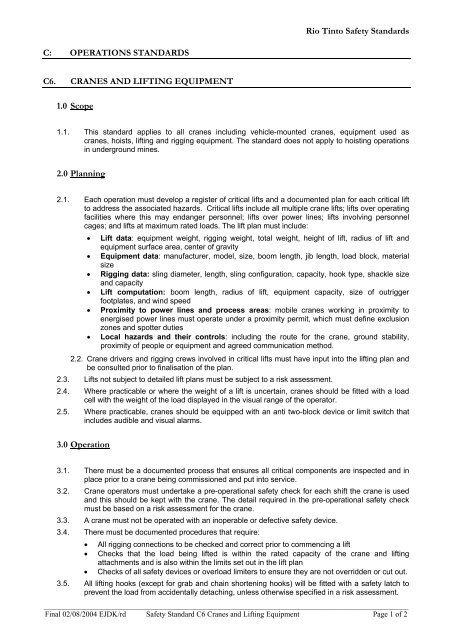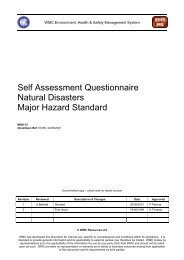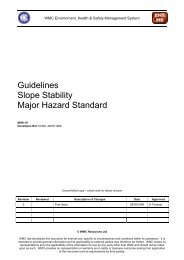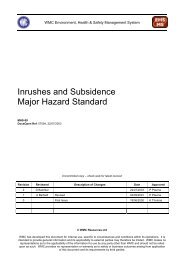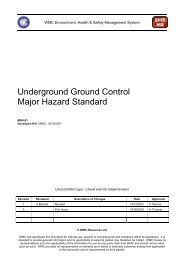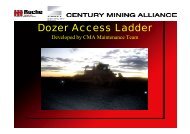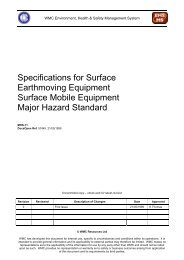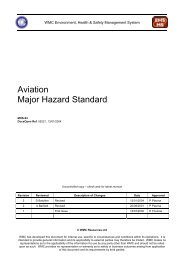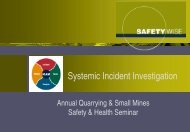RT Safety Standard C6 Cranes and Lifting Standard ... - MIRMgate
RT Safety Standard C6 Cranes and Lifting Standard ... - MIRMgate
RT Safety Standard C6 Cranes and Lifting Standard ... - MIRMgate
Create successful ePaper yourself
Turn your PDF publications into a flip-book with our unique Google optimized e-Paper software.
Rio Tinto <strong>Safety</strong> <strong>St<strong>and</strong>ard</strong>s<br />
C: OPERATIONS STANDARDS<br />
<strong>C6</strong>. CRANES AND LIFTING EQUIPMENT<br />
1.0 Scope<br />
1.1. This st<strong>and</strong>ard applies to all cranes including vehicle-mounted cranes, equipment used as<br />
cranes, hoists, lifting <strong>and</strong> rigging equipment. The st<strong>and</strong>ard does not apply to hoisting operations<br />
in underground mines.<br />
2.0 Planning<br />
2.1. Each operation must develop a register of critical lifts <strong>and</strong> a documented plan for each critical lift<br />
to address the associated hazards. Critical lifts include all multiple crane lifts; lifts over operating<br />
facilities where this may endanger personnel; lifts over power lines; lifts involving personnel<br />
cages; <strong>and</strong> lifts at maximum rated loads. The lift plan must include:<br />
• Lift data: equipment weight, rigging weight, total weight, height of lift, radius of lift <strong>and</strong><br />
equipment surface area, center of gravity<br />
• Equipment data: manufacturer, model, size, boom length, jib length, load block, material<br />
size<br />
• Rigging data: sling diameter, length, sling configuration, capacity, hook type, shackle size<br />
<strong>and</strong> capacity<br />
• Lift computation: boom length, radius of lift, equipment capacity, size of outrigger<br />
footplates, <strong>and</strong> wind speed<br />
• Proximity to power lines <strong>and</strong> process areas: mobile cranes working in proximity to<br />
energised power lines must operate under a proximity permit, which must define exclusion<br />
zones <strong>and</strong> spotter duties<br />
• Local hazards <strong>and</strong> their controls: including the route for the crane, ground stability,<br />
proximity of people or equipment <strong>and</strong> agreed communication method.<br />
2.2. Crane drivers <strong>and</strong> rigging crews involved in critical lifts must have input into the lifting plan <strong>and</strong><br />
be consulted prior to finalisation of the plan.<br />
2.3. Lifts not subject to detailed lift plans must be subject to a risk assessment.<br />
2.4. Where practicable or where the weight of a lift is uncertain, cranes should be fitted with a load<br />
cell with the weight of the load displayed in the visual range of the operator.<br />
2.5. Where practicable, cranes should be equipped with an anti two-block device or limit switch that<br />
includes audible <strong>and</strong> visual alarms.<br />
3.0 Operation<br />
3.1. There must be a documented process that ensures all critical components are inspected <strong>and</strong> in<br />
place prior to a crane being commissioned <strong>and</strong> put into service.<br />
3.2. Crane operators must undertake a pre-operational safety check for each shift the crane is used<br />
<strong>and</strong> this should be kept with the crane. The detail required in the pre-operational safety check<br />
must be based on a risk assessment for the crane.<br />
3.3. A crane must not be operated with an inoperable or defective safety device.<br />
3.4. There must be documented procedures that require:<br />
• All rigging connections to be checked <strong>and</strong> correct prior to commencing a lift<br />
• Checks that the load being lifted is within the rated capacity of the crane <strong>and</strong> lifting<br />
attachments <strong>and</strong> is also within the limits set out in the lift plan<br />
• Checks of all safety devices or overload limiters to ensure they are not overridden or cut out.<br />
3.5. All lifting hooks (except for grab <strong>and</strong> chain shortening hooks) will be fitted with a safety latch to<br />
prevent the load from accidentally detaching, unless otherwise specified in a risk assessment.<br />
________________________________________________________________________________________________<br />
Final 02/08/2004 EJDK/rd <strong>Safety</strong> <strong>St<strong>and</strong>ard</strong> <strong>C6</strong> <strong>Cranes</strong> <strong>and</strong> <strong>Lifting</strong> Equipment Page 1 of 2
3.6. Loads must not swing over people or occupied buildings <strong>and</strong> no person shall be under a<br />
suspended load or in a position where they could be struck by a falling load. Where there is a<br />
risk of a load falling <strong>and</strong> striking a person, barricading or similar controls to prevent access must<br />
be in place.<br />
3.7. The operator shall not leave the crane controls while a load is suspended.<br />
3.8. Overhead travelling cranes must be fitted with audible travel alarms or an equivalent warning<br />
device.<br />
3.9. Tag lines must be attached to loads that require steadying or guidance while suspended. The<br />
load must be well secured <strong>and</strong> properly balanced in the sling or lifting device.<br />
3.10. There must be a documented <strong>and</strong> approved method for communication between the crane<br />
driver <strong>and</strong> those assisting with the lift.<br />
3.11. A procedure must be in place to prevent the use of lifting or rigging equipment in lifting<br />
operations if such equipment has been used for towing.<br />
3.12. Mobile cranes must have a rating capacity chart fixed in a position visible to the crane operator<br />
or available in the crane cabin.<br />
3.13. Operator control stations for vehicle-mounted cranes must be located in an area protected from<br />
swinging loads <strong>and</strong> from the crane jib.<br />
3.14. Slew pins must be secured in place in mobile cranes while travelling.<br />
3.15. Slewing to test the integrity of outriggers on mobile cranes must be conducted prior to<br />
commencing lifts.<br />
4.0 Maintenance <strong>and</strong> Inspection<br />
4.1. A register of cranes, hoists, rigging attachments <strong>and</strong> lifting slings must be established.<br />
4.2. Any crane brought to site must have a current test certificate <strong>and</strong> a pre-use safety inspection to<br />
ensure the crane is fit for purpose. As a minimum, this inspection must satisfy regulatory <strong>and</strong><br />
manufacturer requirements for frequency of inspection <strong>and</strong> physical condition of the machine.<br />
4.3. There must be a system for the inspection, maintenance <strong>and</strong> approval of lifting equipment,<br />
including a process that verifies the equipment is able to function to its design specifications <strong>and</strong><br />
the integrity of:<br />
• Mechanical <strong>and</strong> electrical components<br />
• Controls for each piece of lifting or rigging equipment<br />
• Crane cables <strong>and</strong> all lifting attachments<br />
• Structural components of the hoist, brakes, wheels, hooks, hook-blocks <strong>and</strong> rails<br />
• Integrity of load limiting devices, safety devices, limit switches <strong>and</strong> control systems required<br />
for individual equipment e.g. independent fail-safe braking systems, a device to stop the<br />
crane such as a “dead-persons” switch, <strong>and</strong> emergency shut-off switch.<br />
4.4. Inspections <strong>and</strong> repairs to cranes, cables <strong>and</strong> lifting equipment must comply with the<br />
manufacturers specifications <strong>and</strong> regulatory requirements as a minimum.<br />
4.5. Records of maintenance inspections <strong>and</strong> cable tests must be kept.<br />
5.0 Training<br />
5.1 Personnel must be trained, competent <strong>and</strong> authorised if they operate cranes; set-up or rig loads;<br />
provide signals for controlling lifts; or inspect, maintain or test cranes, hoists, personnel cages,<br />
lifting or rigging equipment.<br />
5.2 There must be a system for establishing minimum operating time, frequency of operation <strong>and</strong><br />
testing to ensure competency for each class of crane.<br />
________________________________________________________________________________________________<br />
Final 02/08/2004 EJDK/rd <strong>Safety</strong> <strong>St<strong>and</strong>ard</strong> <strong>C6</strong> <strong>Cranes</strong> <strong>and</strong> <strong>Lifting</strong> Equipment Page 2 of 2


